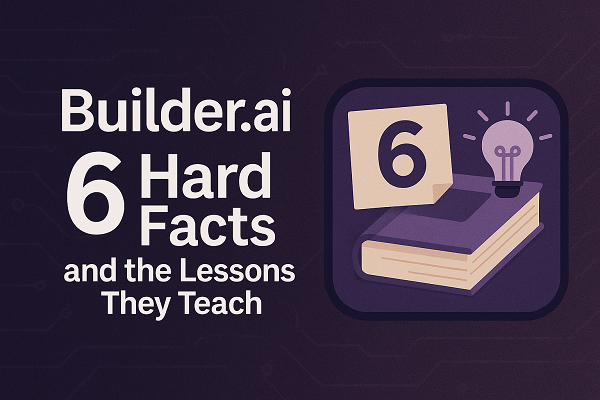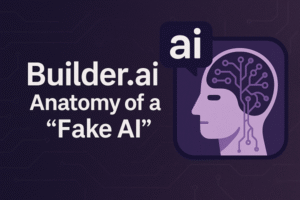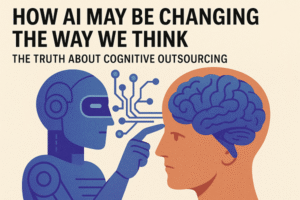A wake-up call for the AI ecosystem — founders, investors, and customers alike.
The rise of artificial intelligence has brought with it massive innovation — and just as much hype. Builder.ai positioned itself as a game-changer in AI-driven app development. But when the truth surfaced, it exposed a dangerous pattern of overpromising and underdelivering.
This blog post highlights 6 hard facts about Builder.ai and the lessons every founder, investor, and customer should learn from them.
1 Mislabeling Manual Work as AI
🧾 Fact: Builder.ai claimed it used AI, but most of the work was done by humans.
📚 Lesson: Misrepresenting services as “AI” erodes trust and damages the credibility of real innovations.
Why It Matters
AI claims attract funding and media buzz. But false claims, when uncovered, lead to mistrust, layoffs, and long-term reputational damage.
🛑 Avoid the Trap
Never label manual labor or simple automation as AI to chase valuation or attention.
✅ What To Do
- Founders: Only use “AI” if it learns, predicts, or automates.
- Investors: Demand a clear breakdown of machine vs human contributions.
- Customers: Ask what the AI actually does — and expect specifics, not jargon.
2 Selling the Dream as if It Already Exists
🧾 Fact: Builder.ai marketed future visions as current capabilities.
📚 Lesson: Overpromising destroys trust once the truth surfaces.
Why It Matters
A misleading pitch may win early attention but risks long-term fallout when expectations crash.
🛑 Avoid the Trap
Clearly separate what’s live from what’s aspirational.
✅ What To Do
- Founders: Communicate product maturity honestly.
- Investors: Separate roadmap from reality in due diligence.
- Customers: Test real features — don’t buy based on mockups.
3 Investors Skipped the Tech Vetting
🧾 Fact: Many investors funded Builder.ai without investigating its tech.
📚 Lesson: Hype and charisma are not substitutes for diligence.
Why It Matters
Investor losses were tied to assumptions, not validation.
🛑 Avoid the Trap
Due diligence is not optional — it’s your protection.
✅ What To Do
- Founders: Be transparent and welcome scrutiny.
- Investors: Validate with technical experts, not just execs.
- Customers: Always test before committing.
4. Calling All Software “AI”
🧾 Fact: Builder.ai blurred the lines between standard services and AI.
📚 Lesson: Charging AI-level prices for non-AI solutions is unethical — and unsustainable.
Why It Matters
When the illusion breaks, value and trust evaporate.
🛑 Avoid the Trap
Not all software is AI. Use the term with technical precision.
✅ What To Do
- Founders: Be specific — don’t let marketing outpace reality.
- Investors: Ask how the tech scales. AI scales cheaply; services don’t.
- Customers: Ask if the system learns or adapts. If not — it’s not AI.
5. Internal Teams Were Misled
🧾 Fact: Employees thought they were building AI, but were part of a manual workflow.
📚 Lesson: Misleading your team breeds disengagement and internal collapse.
Why It Matters
Your people can’t innovate if they don’t understand the mission — or if they feel deceived.
🛑 Avoid the Trap
Don’t spin the story internally. Align on facts, not fantasies.
✅ What To Do
- Founders: Clarify product reality for your team.
- Investors: Ask employees what they think they’re building.
- Customers: Ask, “Who powers the platform — code or staff?”
6. Trust Once Lost Is Hard to Regain
🧾 Fact: The truth cost Builder.ai its credibility — for good.
📚 Lesson: In AI and tech, integrity is your most valuable currency.
Why It Matters
Trust can take years to earn — and seconds to destroy.
🛑 Avoid the Trap
The truth will come out. Always choose transparency first.
✅ What To Do
- Founders: Be honest, even if it slows growth.
- Investors: Back integrity, not just ambition.
- Customers: Support companies that are transparent about limitations.
⚠️ Final Thought: Truth Over Hype
Builder.ai didn’t just fail because of a flawed product —
It failed because it sold illusion instead of reality.
In the age of AI, remember:
Trust must be earned. Validate before you buy. Verify before you invest. Tell the truth before it’s exposed.




